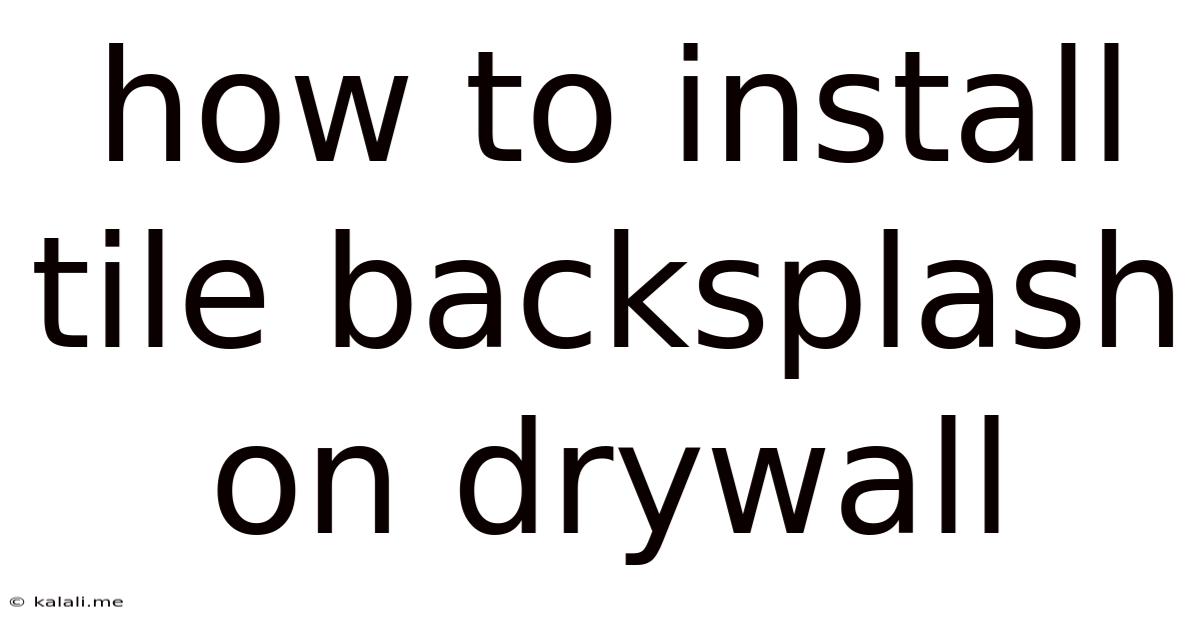How To Install Tile Backsplash On Drywall
Kalali
Jun 10, 2025 · 4 min read

Table of Contents
How to Install a Tile Backsplash on Drywall: A Step-by-Step Guide
Installing a tile backsplash is a rewarding DIY project that can dramatically upgrade your kitchen or bathroom. This comprehensive guide will walk you through the process of installing a tile backsplash on drywall, ensuring a professional-looking finish. This guide covers everything from prepping the wall to grouting and sealing, making your backsplash installation a success.
Keywords: Tile backsplash installation, drywall backsplash, kitchen backsplash, bathroom backsplash, DIY backsplash, tiling tutorial, home improvement, tile installation guide.
1. Preparation is Key: Gathering Your Supplies and Prepping the Wall
Before you even think about laying the first tile, meticulous preparation is crucial. This phase sets the foundation for a flawless backsplash. Here's what you'll need:
- Tools: Measuring tape, level, pencil, utility knife, drywall saw (if needed), trowel (notched and flat), grout float, sponge, bucket, safety glasses, work gloves.
- Materials: Drywall, backer board (highly recommended!), tile, thin-set mortar, grout, silicone caulk, primer, paintable caulk (optional), tile spacers, wet saw (optional, but highly recommended for precise cuts).
Wall Preparation:
- Clean the wall: Thoroughly clean the area where you'll be installing the tiles. Remove any dust, grease, or loose paint.
- Assess the Drywall: Check for any damage or imperfections. Repair any holes or cracks with drywall compound and allow it to dry completely. Consider using backer board for added strength and water resistance, especially in areas prone to moisture like a kitchen backsplash. This is particularly crucial if you are using natural stone tiles which can be heavy.
- Prime the wall (optional but recommended): Applying a primer ensures better adhesion of the thin-set mortar to the drywall. This is especially beneficial for porous drywall.
- Measure and mark: Carefully measure the area to be tiled and mark the layout on the wall. This helps in achieving a visually appealing and balanced backsplash design. Consider starting from a central point for a symmetrical look.
2. Installing the Backer Board (Highly Recommended)
Using backer board significantly enhances the longevity and durability of your tile backsplash, especially in areas prone to moisture. Here's how to install it:
- Cut the backer board: Measure and cut the backer board to fit your designated area. Use a utility knife or a drywall saw for accurate cuts.
- Apply thin-set mortar: Apply a thin layer of thin-set mortar to the wall using a notched trowel.
- Attach the backer board: Press the backer board firmly against the wall, ensuring it's level and secure. Use screws to attach the backerboard to the studs if required for added stability.
3. Laying the Tiles: A Step-by-Step Guide
This is the most visually impactful step, requiring precision and patience.
- Mix the thin-set mortar: Follow the manufacturer's instructions for mixing the thin-set mortar. The consistency should be like peanut butter.
- Apply thin-set: Apply a thin layer of thin-set mortar to the backer board using a notched trowel. The notches create grooves for the tiles to sit in and improve the adhesion of the mortar.
- Place the tiles: Carefully place the tiles onto the thin-set mortar, using tile spacers to maintain consistent grout lines. Press firmly to ensure proper adhesion. Start from a central point, working outwards to ensure symmetry and avoid awkward cuts on the edge.
- Cut tiles (if necessary): Use a wet saw (recommended for precise cuts) or a tile cutter to cut tiles to fit around outlets, corners, and edges. Always wear safety glasses when cutting tiles.
- Allow to dry: Let the thin-set mortar cure completely according to the manufacturer's instructions, usually 24-48 hours.
4. Grouting: Completing the Backsplash
Grouting fills the gaps between the tiles, creating a finished, waterproof surface.
- Mix the grout: Mix the grout according to the manufacturer's instructions. Aim for a smooth, workable consistency.
- Apply the grout: Use a grout float to apply the grout diagonally across the tile surfaces, pressing firmly into the gaps.
- Remove excess grout: After applying the grout, use the grout float to remove the excess grout from the surface of the tiles, working at a 45-degree angle.
- Clean the tiles: Use a damp sponge to clean the tiles, removing any remaining grout residue. Be gentle to avoid damaging the grout lines. Repeat this process several times until the tiles are clean.
- Allow to dry: Allow the grout to dry completely according to the manufacturer's instructions.
5. Sealing (Optional but Recommended): Protecting Your Investment
Sealing the grout protects it from stains and moisture damage, especially in high-moisture areas.
- Apply sealant: Use a sealant specifically designed for grout. Apply it according to the manufacturer's instructions using a brush or sponge.
- Allow to dry: Allow the sealant to dry completely before using the backsplash.
By following these steps, you can successfully install a beautiful and durable tile backsplash on drywall. Remember to always prioritize safety and take your time to achieve the best results. Enjoy your newly renovated space!
Latest Posts
Latest Posts
-
How Many Slices Of Turkey In 2 Oz
Jul 01, 2025
-
Omnipoint Miami E License Llc Miami Fl
Jul 01, 2025
-
Mi Familia Fuera La M S Grande Correct Incorrect
Jul 01, 2025
-
How Much Is 20 Pounds Of Pennies Worth
Jul 01, 2025
-
How Much Does A Gallon Oil Weigh
Jul 01, 2025
Related Post
Thank you for visiting our website which covers about How To Install Tile Backsplash On Drywall . We hope the information provided has been useful to you. Feel free to contact us if you have any questions or need further assistance. See you next time and don't miss to bookmark.